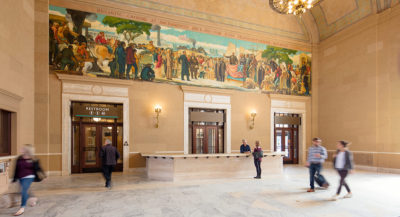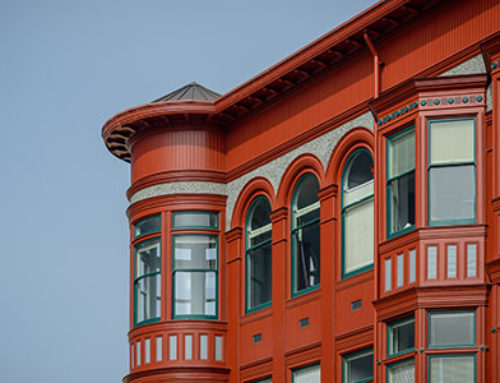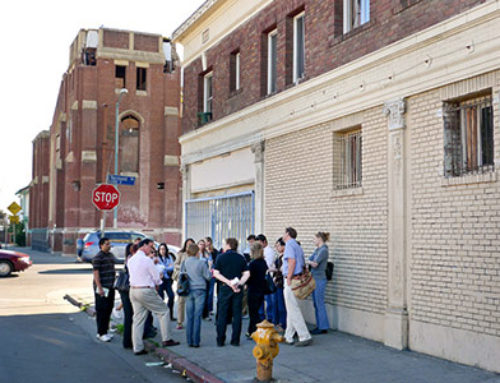
RECOGNITION
Grand piece of Sacramento civic art has come back to life
Sacramento Valley Station
the sacramento bee
Preservationists in lab coats knelt on scaffolding for months this year downtown, delicately swirling cotton swabs with distilled water across the historic wall mural in the great hall of the Amtrak station.
Their work is now done. One of Sacramento’s most ambitious civic art pieces, a mural that depicts the launching of the transcontinental railroad in 1863, has its youthful zest back.
The cleaning is believed to be the first since the train depot at Fourth and I streets opened in 1926. Nearly a century of bustle in the depot hall had browned the mural’s surface with dirt and nicotine stains. City officials say they are pleased with the result.
The city took advantage of a $25,000 grant from the Sacramento Metropolitan Arts Commission to pay for much of the work. The project, launched last spring, required the station’s interior to be jammed with scaffolding, planks and tarps to keep the work area separate from train passengers below.
Preservationists from the New York-based firm of Evergreen Architectural Arts cleaned the mural, repainted portions, reattached peeled seams and applied varnish. Crews also repaired the decorative medallions in the hall’s vaulted roof, restored chandeliers and repainted the walls, mimicking the original sandy texture.
The work is part of a $30 million rehabilitation of Sacramento Valley Station by the city of Sacramento, which owns the building, and by Rudolph and Sletten, a Silicon Valley-based contractor with offices in Roseville.
When the full building restoration is complete around the end of 2016, the building will be transformed not only into a modern transit hub, but also will become a venue for offices, stores and restaurants.
Taylor said the building will have a new ticketing hall, upstairs office space, and restaurant and cafe spaces. It will also have stores above an old loading dock on the east side, much like the landings at the Marrs Building, Fox and Goose and the Warehouse Artist Lofts project elsewhere in downtown and midtown.
The panoramic artwork was painted by artist John MacQuarrie, who specialized in depotmurals around the country, often giving major events a heroic feel. In this case,Taylor said, research shows that the event was not nearly as grand as the mural indicates, although the transcontinental railroad was arguably as important to the growth of Sacramento as the Gold Rush 14 years before.
Standing amid railroad workers, families and business leaders are the state’s Big Four railroad backers, Charles Crocker, Collis Huntington, Leland Stanford and Mark Hopkins, painted nearly life-size. Railroad engineer Theodore Judah stands off to the side looking on (Taylor notes that Judah actually died before the groundbreaking). Steamships and sailing ships float on the Sacramento River in the background. Families watch from a Conestoga wagon. Men watch on horseback, others squat in the dirt. An American flag waves overhead.
Speaking earlier this year to The Bee, local preservationist Melisa Gaudreau, an architect with Page and Turnbull, said the cleanup will help Sacramentans and visitors see and appreciate a piece of history.
“The mural reminds us how transportation and connectivity spur growth and development,” Gaudreau said. “The transcontinental railroad fundamentally changed the development of Sacramento and our region. It’s nice once in a while to have a reminder of how far we have come and what this meant as a moment in time for this region.
“Hopefully more people will have a chance to view it in all its glory.”

